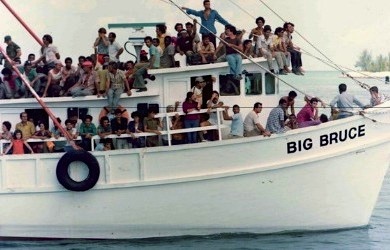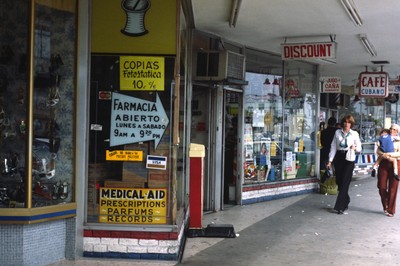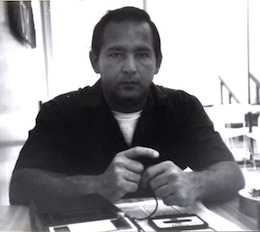"Little Havana" -- Cuban Culture in Miami since Castro
Dan Bryan, May 15 2012
Before 1960, the population of Cuban-Americans living in Miami was very small. With the rise of Fidel Castro however, their presence soon came to define that city. By 1980, Cuban exiles made up over half of the population in Miami. In different ways, their community has come to embody the best and the worst of American life.
When the first Cuban exiles arrived, they brought a culture at odds with the provincial, southern residents who lived there previously. They also brought a political radicalism that -- for better or worse -- has forced a hard line with Cuba ever since.
In the years since, they have built prosperous lives and careers in the United States, and their community is now a permanent fixture.
The initial refugees
In 1960, as Castro consolidated his control and began to move Cuba towards the Communist system, refugees fled the country for Florida. Many of the first to leave were wealthy landowners (though they lost much of this wealth in transit), and were generally from the upper classes of Cuban society. As time went on, they were joined by a wider range of refugees. Many were airlifted out over the years, and by 1973 about 250,000 had left Cuba.
The first refugees envisioned their stay in the United States as a temporary phenomenon, and they expected that Castro's dictatorship would be short-lived. In the aftermath of the Bay of Pigs fiasco, in 1962, Cuban exile hatred towards John F. Kennedy became fanatical. As it became apparent that Castro wasn't going anywhere, the initial members of this community hardened into their right-wing mindset that they are largely known for to this day. Even in the 1980s a prominent exile told Joan Didion, "I would say that John F. Kennedy is still the second most hated man in Miami."
In the decades after 1962, the Cuban community formed a reliable Republican voting bloc in the state of Florida. Many of them became business owners and were natural supporters of a more pro-business platform. In return, the Republicans (and many Democrats) supported their demands of a long, still-functioning trade embargo with Cuba.
The Mariel Boatlift
A second large wave of Cuban immigrants arrived in 1980. In the midst of political and economic turmoil in Cuba, Castro announced that anyone who wanted to leave Cuba would be permitted to do so. The largest mass of potential emigrants gathered at the port of Mariel.
 A group of Cuban refugees arrive in Florida, 1980.
A group of Cuban refugees arrive in Florida, 1980.Within days, the Cuban exile community was sending boats to this port, and they returned with thousands of refugees. At first they were supported in these efforts by other Americans. Eventually Castro -- embarrassed by the situation -- began to include criminals and mentally ill individuals in the refugee groups, in an attempt to even out the situation.
Only a small part of the Mariel group fell into these categories, but their presence led to a backlash against the open policy towards refugees, and by the end of the year a much stricter regimen was in place. Before that happened, in 1980 alone, about 130,000 Cubans arrived in the United States.
The long reach of the exile community
It has traditionally been a bad idea for a person living in Miami to challenge the Cuban community on political issues. In the 1960s and 70s, this applied especially to fellow Cubans who were seen as traitors to the cause.
The fate of Jose de la Torriente offers one example. In 1970, Torriente started a campaign to raise funds for another invasion of Cuba, and was enthusiastically backed by much of the exile community. Then it was revealed that he had embezzled some of the money, while his stated plan (obviously) failed to come to fruition. On April 12, 1974 he was assassinated in his home.
Other groups turned to bombings. One of the most public figures to attract their wrath in this manner was Emilio Milian, a Miami radio personality. Milian condemned the violence used in other incidents, and in turn his car was rigged with explosives, costing him both of his legs.
In the 1980s, however, there were high profile convictions of Cuban exile terrorists. Eduardo Arocena, one of the most prominent, was sentenced to life in prison by a Federal court.
In recent years, there has been much less of this type of political violence. The most radical members of the community are now quite old (or incarcerated), and their fervor was not picked up at the same level by subsequent generations.
The second and third generation
The hard-line stances of the Cuban community have increasingly been associated with an older generation. Most Cuban-Americans do not have memories of living in Cuba, and have mixed the pervasive influence of Cuban culture with more native ideals. In general, this has meant a moderation in their viewpoint towards American culture and politics.
The Embargo, for instance, has long been politically untouchable. More recent surveys, however, show a change of opinion towards this policy even within the Cuban community.
The future of the Cuban community
It is well known in the United States that Miami is a Cuban-dominated town. While there are a few communities elsewhere, the vast majority of Cuban-Americans have always resided in that city.
While the community began as something separate from the United States' mainstream, it has come to embody the strengths and weaknesses of our culture in their exaggerated form. The exiles, to be sure, are often associated with the presence of gated communities, one-sided conservative fulmination, conspicuous materialism, and an aloofness towards larger American society.
However, they also form one of the most prosperous communities in the United States. Many arrived with nothing except for their clothes, and through hard work and shrewd business acumen have climbed the ladder of society. Lavish quinceañeras and large houses in gated villages are seen as the just rewards of such effort. Strangely, while many of the first refugees expected a short stay in this country, the success of their culture is a vivid idealization of the American dream.
It will be very interesting to see what happens if Communism falls in Cuba -- both in that country itself and within the Cuban community of Miami.
Recommendations/Sources
- Joan Didion - Miami
- Ann Louise Bardach - Cuba Confidential: Love and Vengeance in Miami and Havana


